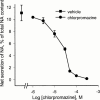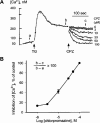Chlorpromazine inhibits store-operated calcium entry and subsequent noradrenaline secretion in PC12 cells
- PMID: 11159689
- PMCID: PMC1572582
- DOI: 10.1038/sj.bjp.0703840
Chlorpromazine inhibits store-operated calcium entry and subsequent noradrenaline secretion in PC12 cells
Abstract
1. The effect of chlorpromazine on the store-operated Ca2+ entry activated via the phospholipase C signalling pathway was investigated in PC12 cells. 2. Chlorpromazine inhibited the sustained increase after the initial peak in the intracellular Ca2+ concentration produced by bradykinin while having no effect on the initial transient response. The inhibition was lowered by the removal of extracellular free Ca2+. However, chlorpromazine did not inhibit bradykinin-induced inositol 1,4,5-trisphosphate production. 3. Chlorpromazine inhibited the bradykinin-induced noradrenaline secretion in a concentration-dependent manner (IC(50): 24+/-5 microM, n=3). 4. To test for a direct effect of chlorpromazine on store-operated Ca2+ entry, thapsigargin, an inhibitor of microsomal Ca(2+)-ATPase, was used to induce store-operated Ca2+ entry in PC12 cells. Chlorpromazine reduced the thapsigargin-induced sustained Ca2+ level (IC(50): 24+/-2 microM, n=3), and the inhibition also occluded the inhibitory action of 1-[-[3-(4-methoxyphenyl) propoxy]-4-methoxyphenyl]-1H-imidazole hydrochloride (SK&F96365). 5. The results suggest that chlorpromazine negatively modulates the store-operated Ca2+ entry activated subsequent to PLC activation.
Figures





Similar articles
-
Multiple effects of 1-[beta-[3-(4-methoxyphenyl)propoxy]-4-methoxyphenethyl]-1H-imidazole hydrochloride (SKF 96365) on Ca2+ signaling in MDCK cells: depletion of thapsigargin-sensitive Ca2+ store followed by capacitative Ca2+ entry, activation of a direct Ca2+ entry, and inhibition of thapsigargin-induced capacitative Ca2+ entry.Naunyn Schmiedebergs Arch Pharmacol. 1999 Feb;359(2):92-101. doi: 10.1007/pl00005336. Naunyn Schmiedebergs Arch Pharmacol. 1999. PMID: 10048593
-
Capsaicin inhibits phospholipase C-mediated Ca(2+) increase by blocking thapsigargin-sensitive store-operated Ca(2+) entry in PC12 cells.J Pharmacol Exp Ther. 1999 Oct;291(1):107-14. J Pharmacol Exp Ther. 1999. PMID: 10490893
-
Multiple effects of econazole on calcium signaling: depletion of thapsigargin-sensitive calcium store, activation of extracellular calcium influx, and inhibition of capacitative calcium entry.Biochim Biophys Acta. 1999 Jan 11;1448(3):533-42. doi: 10.1016/s0167-4889(98)00159-1. Biochim Biophys Acta. 1999. PMID: 9990306
-
Methods for studying store-operated calcium entry.Methods. 2008 Nov;46(3):204-12. doi: 10.1016/j.ymeth.2008.09.009. Epub 2008 Oct 16. Methods. 2008. PMID: 18929662 Free PMC article. Review.
-
Pharmacological Strategies for Manipulating Plant Ca2+ Signalling.Int J Mol Sci. 2018 May 18;19(5):1506. doi: 10.3390/ijms19051506. Int J Mol Sci. 2018. PMID: 29783646 Free PMC article. Review.
Cited by
-
Sigma-1 Receptor Antagonist Haloperidol Attenuates Store-Dependent Ca2+ Entry in Macrophages.Dokl Biochem Biophys. 2018 May;480(1):162-165. doi: 10.1134/S1607672918030109. Epub 2018 Jul 14. Dokl Biochem Biophys. 2018. PMID: 30008101
-
Sigma-1 receptor antagonist haloperidol attenuates Ca2+ responses induced by glutoxim and molixan in macrophages.Dokl Biochem Biophys. 2017 Jan;472(1):74-76. doi: 10.1134/S1607672917010227. Epub 2017 Apr 19. Dokl Biochem Biophys. 2017. PMID: 28421439
-
The Impact of the Antipsychotic Medication Chlorpromazine on Cytotoxicity through Ca2+ Signaling Pathway in Glial Cell Models.Neurotox Res. 2022 Jun;40(3):791-802. doi: 10.1007/s12640-022-00507-5. Epub 2022 Apr 19. Neurotox Res. 2022. PMID: 35438391
-
Dust particles-induced intracellular Ca2+ signaling and reactive oxygen species in lung fibroblast cell line MRC5.Korean J Physiol Pharmacol. 2017 May;21(3):327-334. doi: 10.4196/kjpp.2017.21.3.327. Epub 2017 Apr 21. Korean J Physiol Pharmacol. 2017. PMID: 28461775 Free PMC article.
-
Non-Dioxin-Like Polychlorinated Biphenyls Inhibit G-Protein Coupled Receptor-Mediated Ca2+ Signaling by Blocking Store-Operated Ca2+ Entry.PLoS One. 2016 Mar 10;11(3):e0150921. doi: 10.1371/journal.pone.0150921. eCollection 2016. PLoS One. 2016. PMID: 26963511 Free PMC article.
References
-
- ALONSO-TORRE S.R., GARCIA-SANCHO J. Arachidonic acid inhibits capacitative calcium entry in rat thymocytes and human neutrophils. Biochim. Biophys. Acta. 1997;1328:207–213. - PubMed
-
- BENOIT P., CHANGEUX J.P. Voltage dependencies of the effects of chlorpromazine on the nicotinic receptor channel from mouse muscle cell line So18. Neurosci. Lett. 1993;160:81–84. - PubMed
-
- CHOI S.Y., KIM K.T. Capsaicin inhibits phospholipase C-mediated Ca2+ increase by blocking thapsigargin-sensitive store-operated Ca2+ entry in PC12 cells. J. Pharmacol. Exp. Ther. 1999;291:107–114. - PubMed
-
- ELLENBROEK B.A. Treatment of schizophrenia: a clinical and preclinical evaluation of neuroleptic drugs. Pharmacol. Ther. 1993;57:1–78. - PubMed
Publication types
MeSH terms
Substances
LinkOut - more resources
Full Text Sources
Miscellaneous

